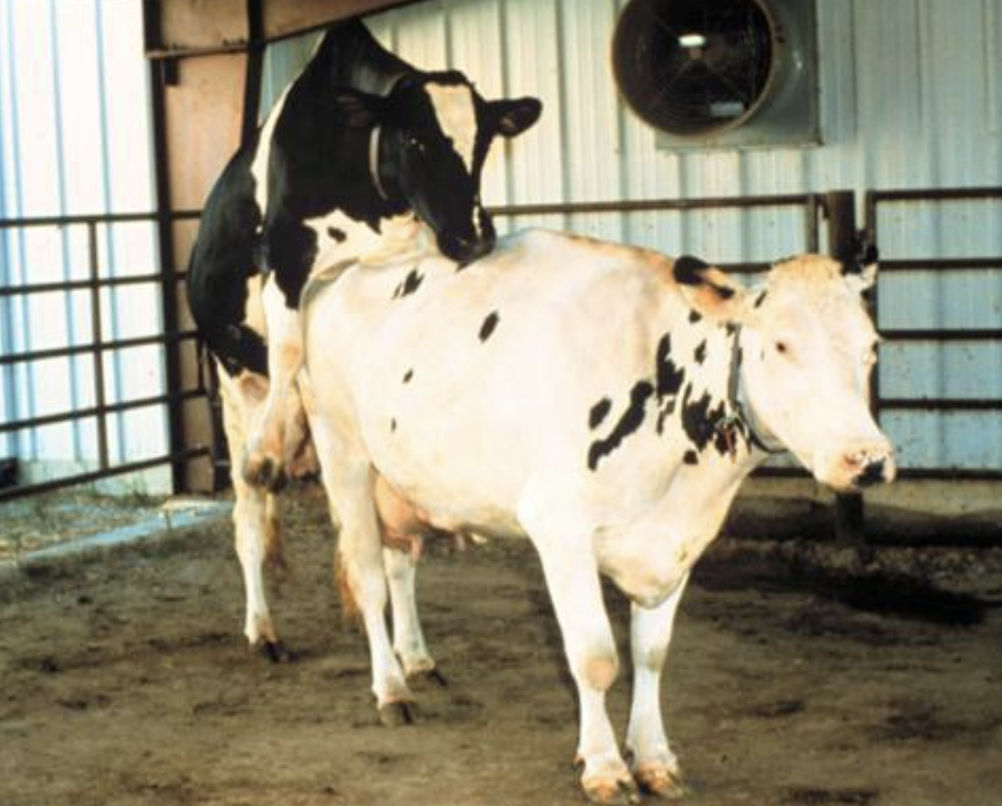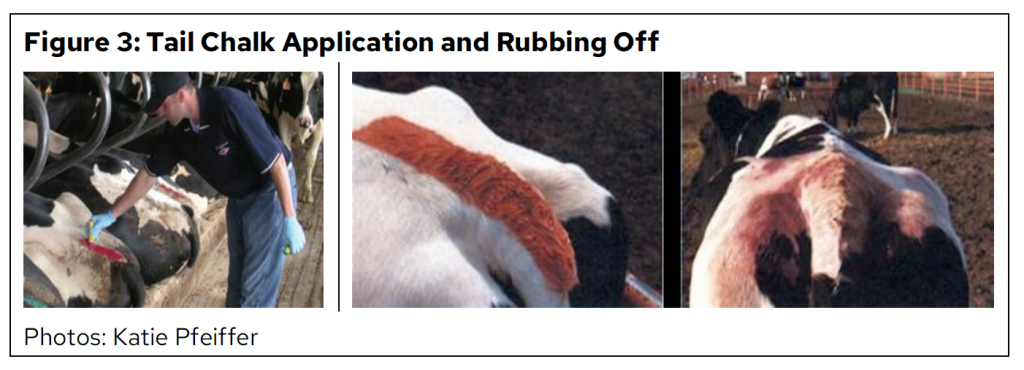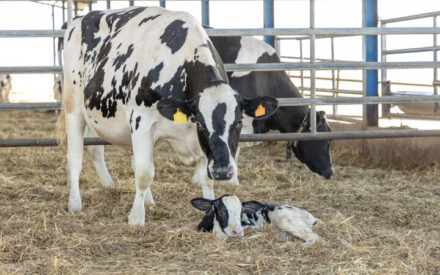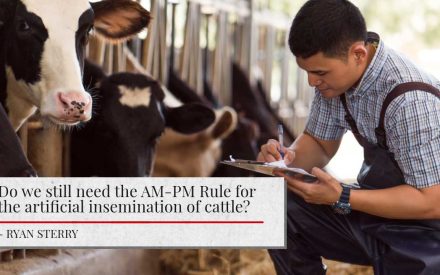Estrus detection, commonly referred to as heat detection, is one of the most important reproductive management tasks performed on the farm. Simply put, if cows are not identified in estrus they will not be bred by Artificial Insemination (AI) and have no chance of becoming pregnant. Estrus detection accuracy is also critical. If cows are falsely identified in estrus, or identified too late, they will also not have a chance to become pregnant because they will not be fertile at the time of AI.
The estrous cycle for cattle is typically 21 days and it is normal for cattle to have estrous cycles as short as 17 days and as long as 24 days. Heifers tend to have a shorter estrous cycle, ranging from 17 to 21 days, than lactating dairy cows which can vary from 18 to 24 days. Cows and heifers also have differences in the average duration of estrus activity. Heifers tend to be in estrus longer, with more standing events, than lactating cows. Table 1 illustrates the relationship of cycle length, estrus duration and ovulation.
Estrus expression is due to the reproductive hormones present during the estrous cycle. Figure 1 illustrates the relationship between the day of the cycle and the hormone that influences behavior. The hormone estrogen is responsible for estrus behavior.
| Table 1: Estrous Cycle Length and Duration of Estrus | |||
| Estrous cycle length | Duration of Estrus (Heat) | Time from onset of Estrus to ovulation | |
| Average | 21 days | 15 hours | 24-32 hours |
| Range | 17-24 days | 6-24 hours | |
| Senger, PL; Pathways to Pregnancy and Parturition | |||
Figure 1: Estrous Cycle diagram with active hormones.
What to look for when detecting estrus
- Increased movement and restlessness
- Increased vocalization or bellowing
- Nervousness
- Attempting to mount other animals
- Very small amount of watery mucus or discharge from the vulva
When cows and heifers enter estrus, they do so gradually, and are not immediately receptive to a bull. In herds that use AI, and no bull is present, cattle in early estrus (proestrus) will not stand to be mounted by herd mates. Early signs to look for include:
Standing estrus is the next stage that is initiated by the influence of estrogen and is indicated by the cow or heifer standing to be mounted. Standing to be mounted is the primary and most reliable sign of estrus. All other signs are secondary, and while they are important to observe, they do not guarantee a cow or heifer is in estrus.
Figure 2. Observing Standing Estrus

Which cow would you breed? The black cow riding the other cow, or the white cow standing to be mounted?
Standing to be mounted is the primary sign of estrus. The white cow should be the one to receive AI.
Are we still suspicious of the black cow? Yes. Attempting to mount other cows is a secondary sign of estrus. However, more observation is needed before deciding to breed this cow.
Secondary signs of estrus to look for
- Friendlier than normal to caretakers
- Does not eat or spends less time at the feedbunk
- Abundant, more cohesive clear mucus from her vulva
- Red and swollen vulva
After the cow or heifer has ovulated, levels of estrogen decline; they are no longer receptive to mounting and will not stand. Cattle coming out of estrus (Figure 1: metestrus stage) may still attempt to mount other animals. Flanks may be dirty, and cattle may have roughed hair on their tail head from being mounted. Also, a bloody discharge from the vulva may be seen following ovulation.
Farms need a record-keeping and communication system to notify decision-makers when a cow or heifer is coming into estrus, is in estrus, or is no longer in estrus. Knowing where in the estrous cycle a cow or heifer is in allows for better management decisions and prediction of when she will be in estrus again. This includes breeding dates to observe for cows or heifers failing to conceive. Since there is such a short window of fertility after a female is observed in estrus, this information should be communicated immediately, and the female should receive AI shortly after standing is observed.
Factors that affect estrus expression
Traction and season can also impact estrus expression. Concrete surfaces can be slippery, especially if it is not properly grooved or no sand is added for traction; cattle will hesitate to mount, and express fewer standing events for fear of injury. Dirt lots may provide better footing for cattle to express greater standing and mounting activity. Similarly, ice covered surfaces during colder months will cause cattle to less actively express estrus.
| Table 2: Seasonal effects of estrus behavior | ||
| Number of Standing Events | ||
| Breed | Winter | Summer |
| Holstein | 8.6 | 4.5 |
| Jersey | 12.1 | 5.3 |
| Nebel et al., J Dairy Sci 80; 1997 | ||
There is a seasonal effect to how many standing events occur during estrus (Table 2). Research trials have shown more standing events occur during the winter months than the summer months. During times of environmental heat stress cattle may tend to bunch up and not be as active. During the summer months and times of heat stress it becomes increasingly more important to devote time to estrus detection, use estrus detection aids, and provide heat abatement for cattle.
Knowing the time-of-day cattle are more likely to show signs of estrus is important. Cattle show 70% of their standing events during the cooler hours of the day, 6 pm to 6 am. From 6 am to noon, cattle will show 22% of their standing estrus activity, and only 8% of standing events occur from noon to 6 pm. Observing cattle twice a day for 30 minutes in the early morning and the late evening will allow you to make the most of your time and catch the most animals in estrus.
To improve estrus detection rates and accuracy, assign one person to this task. The person in charge should be familiar with the herd and have observed enough “normal” activity of the herd that they can recognize estrus behavior changes. It is also important to properly identify the animals in the herd, so correct information about estrus status can be communicated and proper records can be kept.
Estrus detection aids
Estrus detection aids are tools that help us to recognize that a cow or heifer may be in estrus. They are not a replacement for observing cattle in standing estrus. When properly applied and maintained, though, they are present in the herd 24 hours a day and can indicate un-observed estrus behavior.

Tail paint is an estrus detection aid that is relatively inexpensive. Tail paint is applied in a thick coat to the tail-head of the cow, and the observer checks for the paint to be rubbed off, indicating a cow or heifer stood to be mounted (Figure 3). Tail chalk is like tail paint; however, applying chalk to the tail head requires more pressure. Cattle may need to be restrained to apply tail chalk since the pressure of applying the product may cause them to stand up or walk away. Restraint is also needed so that paint and chalk may be applied to both the top- and underside of the hair, for complete coverage that is more noticeable as being disturbed when animals are in heat.
Pressure-activated devices (Figure 4) are an alternative to paint and chalk. These devices change color when pressure is applied by the brisket of a mounting cow or heifer. These are slightly more expensive than chalk or paint. Pressure-activated devices can give false positive results if an animal leans or lays against a stall post or a tree in pasture. An alternative to the pressure-activated devices are the scratch-off patches. These patches have a “protective” coating overlaying a bright color. As the animal stands to be mounted the “protective” coating is rubbed off exposing the bright color.

Technology
New advancements in technology are occurring all the time, with options engineered to withstand the wear and tear cattle can put on them. Wearable technology, such as activity monitoring pedometers, have been refined for their use in estrus detection. This wearable technology is now also available in ear tag options. Technology is being integrated to combine activity, rumination, and milk production data, to provide more clues for when a cow’s activity is not normal and may indicate estrus.
The presence or absence of milk progesterone indicates the stage of the reproduction cycle lactating cattle are in (Figure 2). In-line systems for monitoring milk progesterone are in development as an additional technology for estrus detection.
Summary
- Estrus detection and proper record-keeping are important for a successful breeding program
- Farm managers and workers need to know the signs of estrus
- Tools and technology are available to aid estrus detection
References
University of Minnesota, Cattle Heat Detection Options https://extension.umn.edu/beef-cow-calf/cattle-estrus-detection
Nebel, R. L., Jobst, S. M., Dransfield, M. B. G., Pandolfi, S. M., & Bailey, T. L. (1997). Use of radio frequency data communication system, HeatWatch®, to describe behavioral estrus in dairy cattle. J. Dairy Sci, 80(Suppl 1), 179.
Senger, P. L. Pathways to pregnancy and parturition.

 ¿Seguimos necesitando la regla A. M. / P. M.?
¿Seguimos necesitando la regla A. M. / P. M.? Activity Monitoring Technology for Reproductive Management of Dairy Cows
Activity Monitoring Technology for Reproductive Management of Dairy Cows Do we still need the AM-PM Rule for the artificial insemination of cattle?
Do we still need the AM-PM Rule for the artificial insemination of cattle? ▶️ Watch: Entendiendo el ciclo estral bovino para mejorar la detección de calores
▶️ Watch: Entendiendo el ciclo estral bovino para mejorar la detección de calores


